Views of the Veil Nebula
Aug 8, 2022 18:00:30 #
Ballard
Loc: Grass Valley, California
The Veil Nebula is the remnant of a super Nova explosion that happened between 10,000 and 20,000 years ago. It can be found in the constellation Cygnus the Swan (also known as the Northern Cross). It subtends across ~ 3 degrees of the sky (6 moon diameters) and is still expanding at around 1 million miles an hour. It is approximately 2400 light years away and 130 light years across. The images below were taken with a 500mm canon lens attached to an ASI 6200MM pro monochrome camera with a filter wheel used to take images using different filters to create color images.
The first image was made using Luminance, Red, Green and Blue filters.
The second image also used LRGB filters but was processed to reduce the star intensities to bring out the nebula.
The third image used a Hydrogen Alpha (Ha) filter in place of the red channel and for the Luminance channel, the Blue and Green were the same as the previous 2 images.
The fourth image used a combination of Hydrogen Alpha and Oxygen 3 (O3) for the Luminance channel, Ha for the Red channel, Green for the Green channel and O3 for the blue channel.
The last images used the Hubble Pallet with Sulphur 2 (S2) used for the Red channel, Ha for the Green Channel and O3 for the Blue channel (no separate Luminance was added).
All questions comments and suggestions are welcome.
For those interested the following exposures were used.
The camera gain was set to 100 and some of the shots were taken a -12C and others at -16C due ambient temperature and how far down the cooler on the camera could bring the sensor down to.
All exposures were guided with an RMS <.5 arcseconds.
Luminance filter (56 exposures at 1 minute length)
Red filter (34 exposures at 2 minutes in length)
Green filter (34 exposures at 2 minutes in length)
Blue filter (40 exposures at 2 minutes in length)
Ha filter (11 exposures a 500 seconds in length)
O3 filter (13 exposures a 500 seconds in length)
S2 filter (10 exposures a 500 seconds in length)
The images were processed with Pixinsight and also used the appropriate Dark, Flat and Bias frames.
The first image was made using Luminance, Red, Green and Blue filters.
The second image also used LRGB filters but was processed to reduce the star intensities to bring out the nebula.
The third image used a Hydrogen Alpha (Ha) filter in place of the red channel and for the Luminance channel, the Blue and Green were the same as the previous 2 images.
The fourth image used a combination of Hydrogen Alpha and Oxygen 3 (O3) for the Luminance channel, Ha for the Red channel, Green for the Green channel and O3 for the blue channel.
The last images used the Hubble Pallet with Sulphur 2 (S2) used for the Red channel, Ha for the Green Channel and O3 for the Blue channel (no separate Luminance was added).
All questions comments and suggestions are welcome.
For those interested the following exposures were used.
The camera gain was set to 100 and some of the shots were taken a -12C and others at -16C due ambient temperature and how far down the cooler on the camera could bring the sensor down to.
All exposures were guided with an RMS <.5 arcseconds.
Luminance filter (56 exposures at 1 minute length)
Red filter (34 exposures at 2 minutes in length)
Green filter (34 exposures at 2 minutes in length)
Blue filter (40 exposures at 2 minutes in length)
Ha filter (11 exposures a 500 seconds in length)
O3 filter (13 exposures a 500 seconds in length)
S2 filter (10 exposures a 500 seconds in length)
The images were processed with Pixinsight and also used the appropriate Dark, Flat and Bias frames.
LRGB image
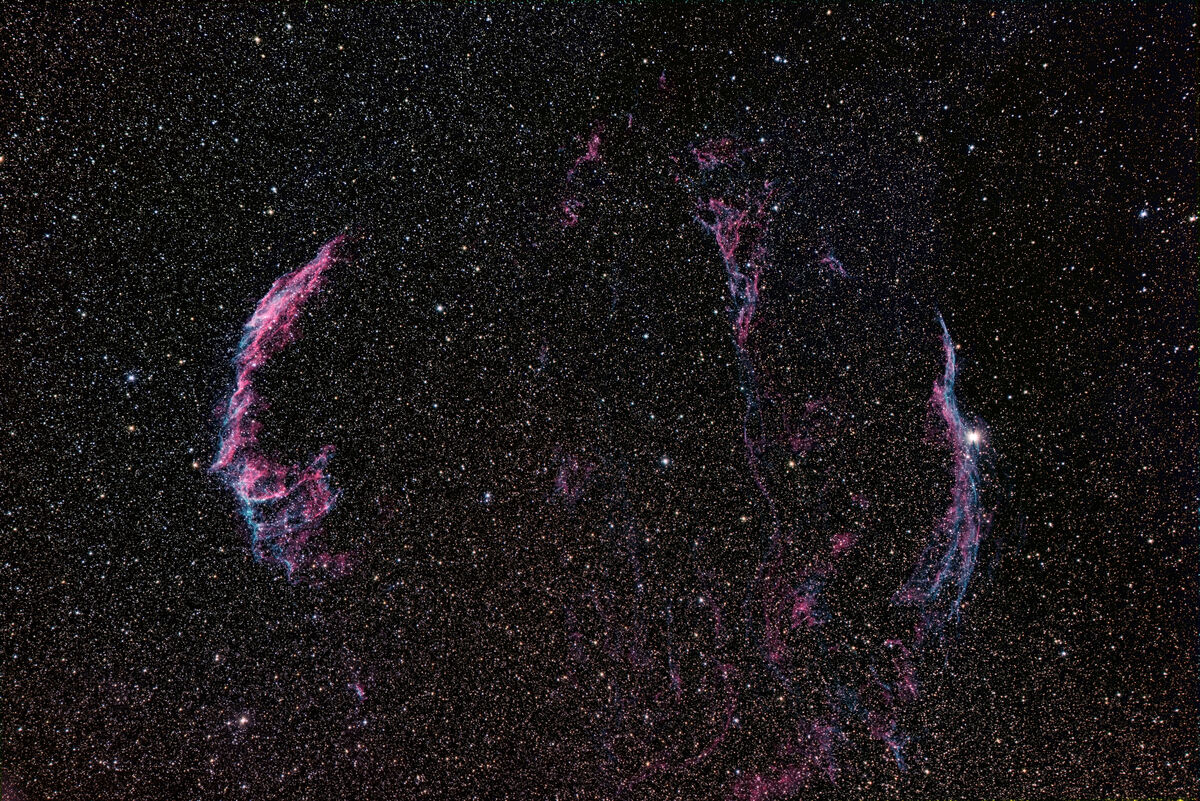
(Download)
LRGB image with star intensity reduced.
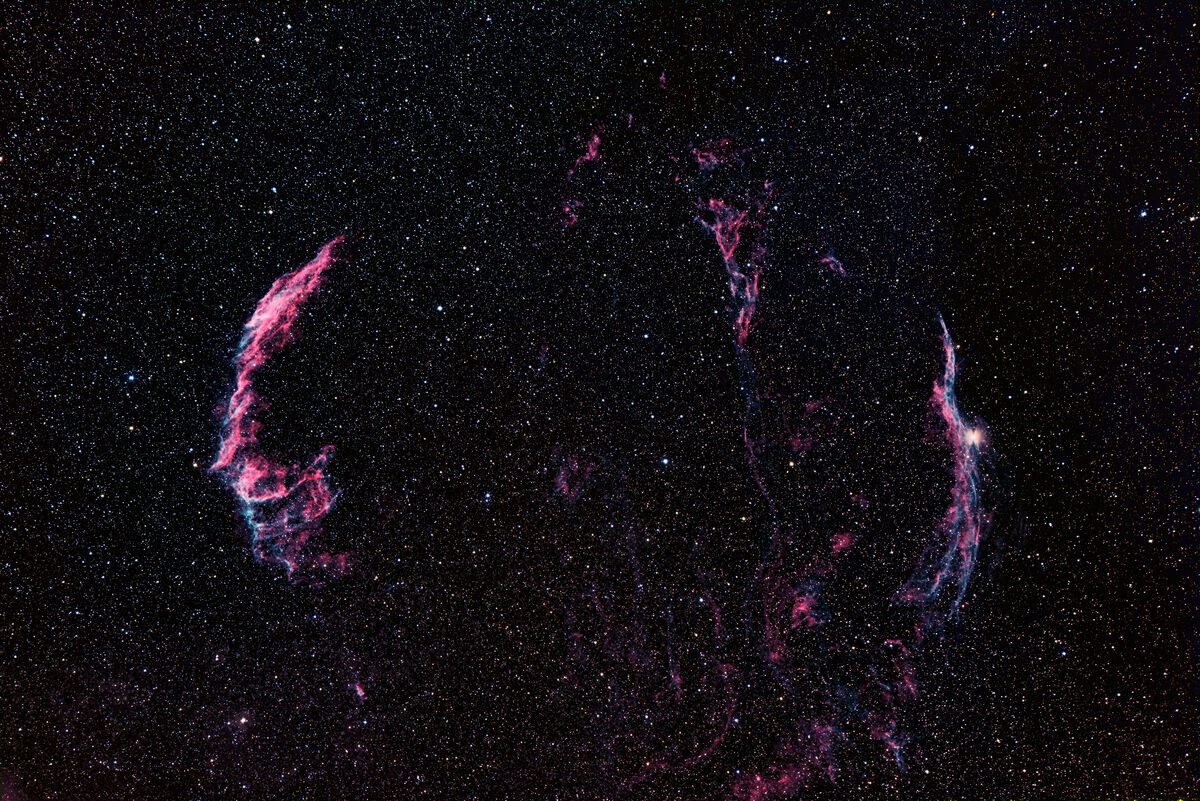
(Download)
Ha used for Red and Luminance channels along with Green and Blue filters
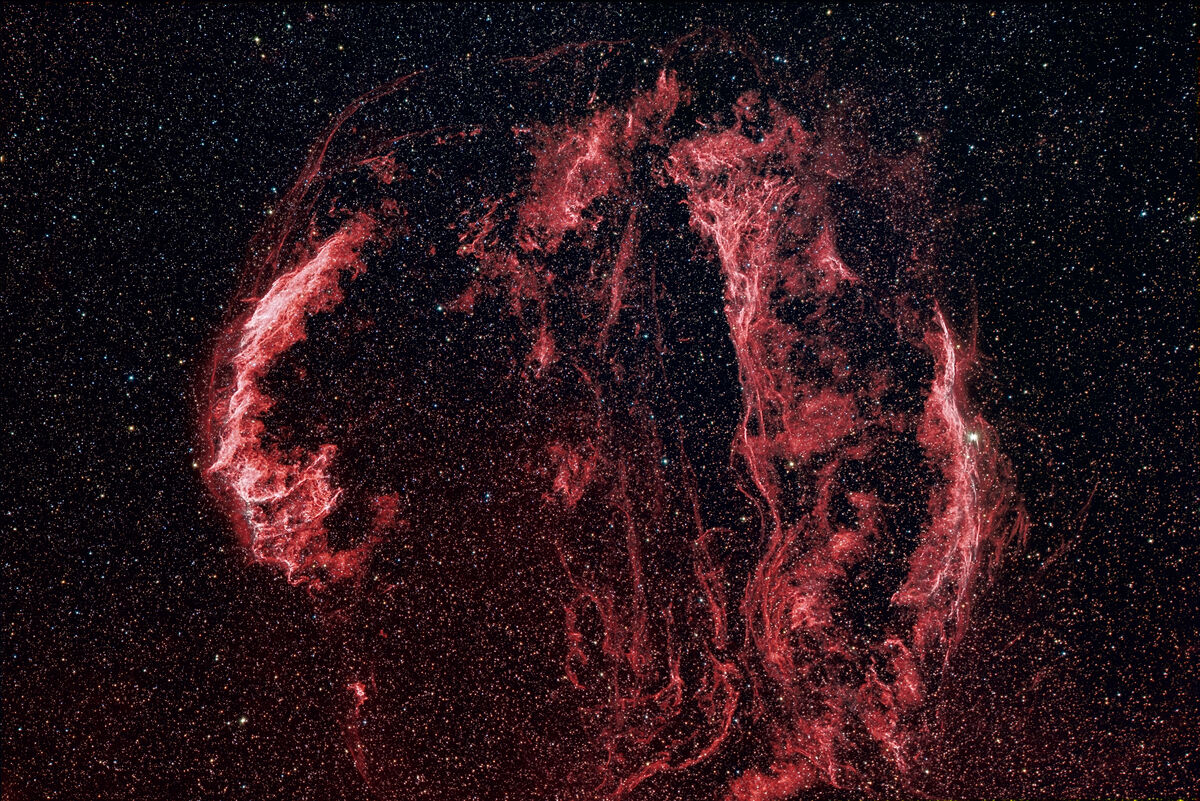
(Download)
Ha Plue O3 used for the Luminance channel, Ha used for the Red Channel, O3 used for the blue channel along with a Green filter
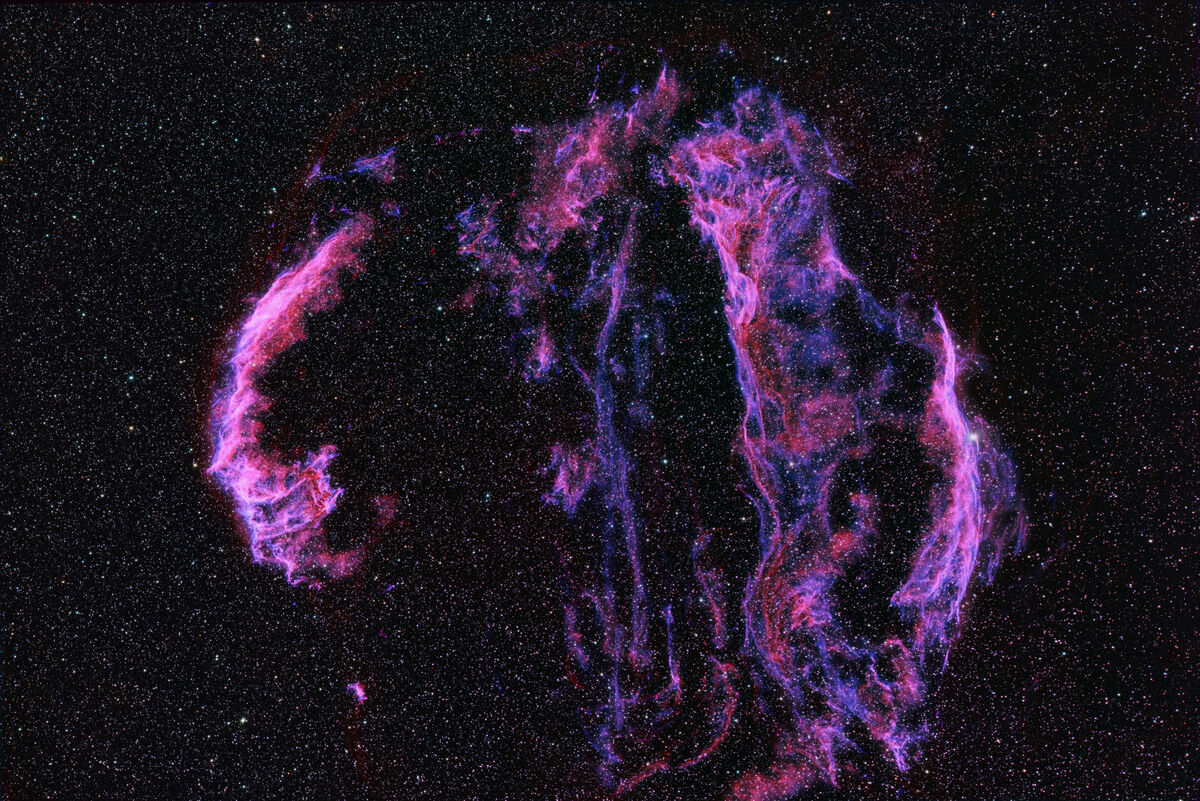
(Download)
S2 used for the Red channel, Ha for the Green Channel and O3 for the Blue channel (Hubble Pallet). Note: the yellow is a combination of Red (S2) and Green (Ha). Blue is Oxygen
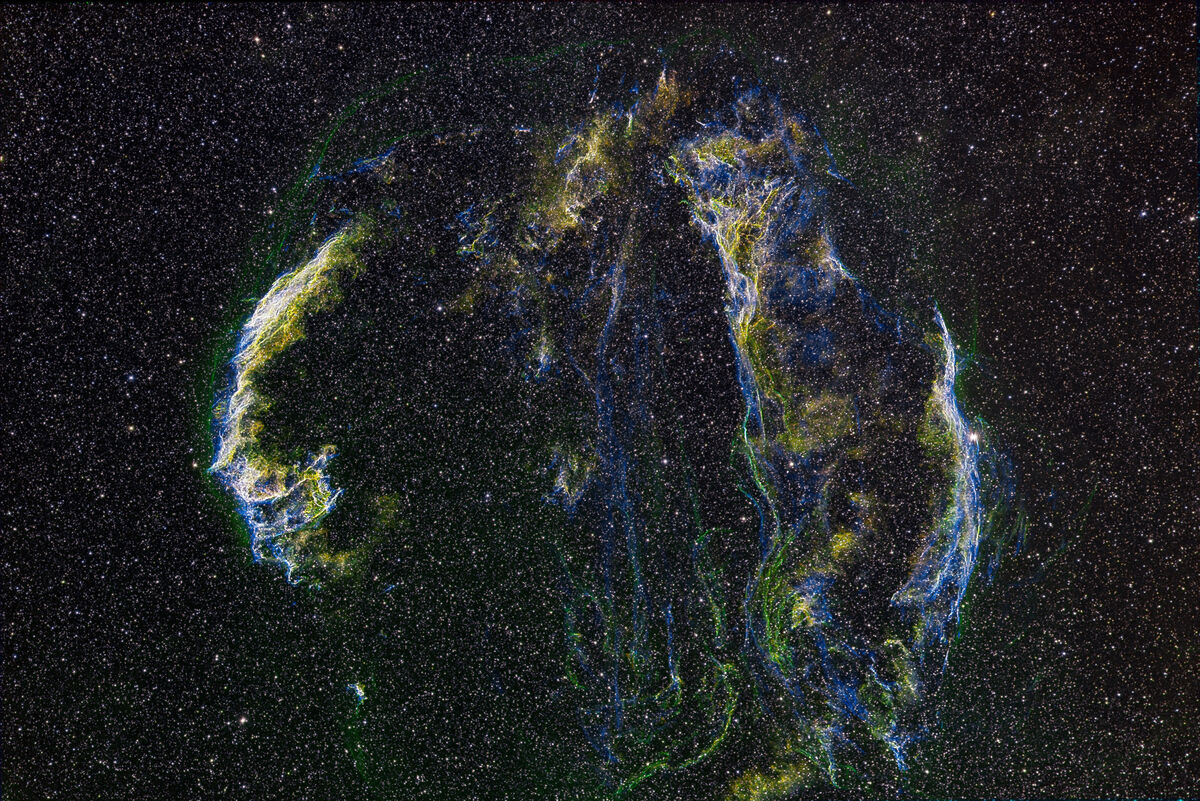
(Download)
Aug 8, 2022 18:25:50 #
Aug 8, 2022 18:35:11 #
Ballard
Loc: Grass Valley, California
khalidikram wrote:
Fantastic! Thank you very much for sharing.
Hi khalidikram
Thanks for checking out the images of the Veil Nebula and for the comment. My pleasure to share them.
Aug 8, 2022 18:49:05 #
gmontjr2350
Loc: Southern NJ
Ballard wrote:
The Veil Nebula is the remnant of a super Nova exp... (show quote)
Gorgeous work!



George
Aug 8, 2022 19:00:33 #
Ballard
Loc: Grass Valley, California
gmontjr2350 wrote:
Gorgeous work!



George



George
Hi George
Thanks for viewing the images of the Veil Nebula, for the comment and the Thumbs up.
Aug 8, 2022 19:43:43 #
Aug 8, 2022 21:02:15 #
Ballard
Loc: Grass Valley, California
PoppieJ wrote:
really like the treatment on the last one
Hi PoppieJ
Thanks for checking out the Veil Nebula images and for the comment. The last one is composed of just Narrow band images and tells the most about the composition of the nebula.
Aug 9, 2022 04:46:57 #
Aug 9, 2022 06:39:57 #
Aug 9, 2022 06:54:21 #
Aug 9, 2022 08:04:36 #
Aug 9, 2022 09:18:49 #
Aug 9, 2022 09:20:13 #
Aug 9, 2022 10:05:01 #
Impressive. Would it be better if you quieted the stars in the bkg a little?
Aug 9, 2022 11:33:52 #
Ballard wrote:
The Veil Nebula is the remnant of a super Nova exp... (show quote)
The Ha really brings out the structure.
I wonder how bright this shone when it first went SuperNova? Our ancestors might have had quite the show!
bwa
If you want to reply, then register here. Registration is free and your account is created instantly, so you can post right away.






